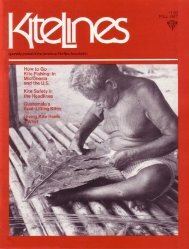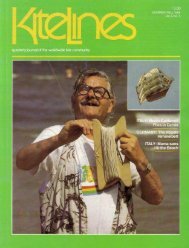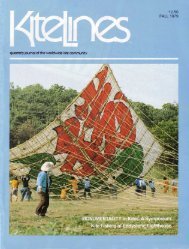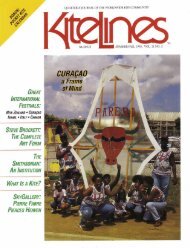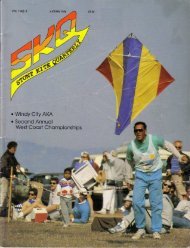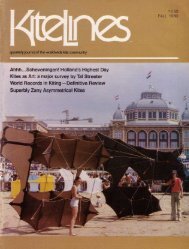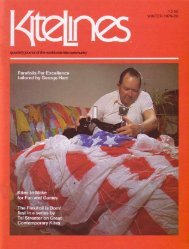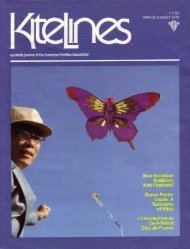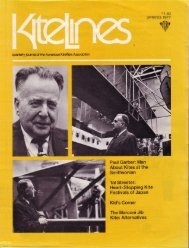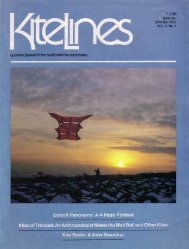You also want an ePaper? Increase the reach of your titles
YUMPU automatically turns print PDFs into web optimized ePapers that Google loves.
What's New(Continued)as the kite approaches the ground andgains speed . Remember, given the sameamount of control input, downturngives decreasing diameter turn, andupturn gives increasing diameter turn .Control movements should be largewhen the kite has low power, or is overheador at the right or left wind limit .They should be small when the kite isbeing launched or is close to theground, when the angle of attack ishigh . As long as the pull on thestrings is unequal, the kite will continueto turn .Understanding neutral is the key toflying a two-line kite . When the pullon both strings is eased, the kite willtravel in a straight line whichever waythe nose points (up, down, or sideways,the kite doesn't care), until the nextmaneuver is initiated or a crash occurs .To gain altitude, put the controls inneutral when the nose of the kite isaimed up . The knack to a smooth,quick climb is to pull on the oppositeline (the one with less pull) at theexact instant the nose of the kite pointsup, pulling in only enough to put thecontrols in neutral, not enough tostart the kite spinning in the oppositedirection . Control of spins and veeringcan be accomplished by pulling in onthe line on the side opposite the onetoward which the kite is turning . Forexample, a clockwise spin (with rightline shorter) can be stopped by pullingin on the left line . This will initiatecounter-clockwise spins .EquipmentFor two-line controllable kites, alwaysuse braided line, such as the varietysold for squidding or bait-casting .Ordinary twisted kite string willrapidly fail from line abrasion . Mostmaneuverable kites can still be flownand controlled with 10 or more twistsin the lines, but as the kite traversesfrom right to left, the lines willsaw against one another . Swivelsat the end of the flying lines mayreduce line twist . The lightest andsmallest-diameter flying line ofappropriate strength will deliver thebest performance .The penalty for two-line controlkiting is doubled cord weight and drag .The weight factor is relatively unimportant,affecting the kite mostlyin overhead stall . But line drag isa limiting factor on the speed ofyour maneuverable . Line drag is proportionalto the cube of the line's crosssectionalarea, so a small reduction inline diameter can have a big effect onthe kite's behavior .Control systems and bridling fortwo-line kites can vary greatly butfall into two types : bare-handed, directmanipulation of the two lines in eachhand ; and use of a device or handleto feed or limit the flow of line betweenflier and kite .Although almost any kite can berigged for two-line maneuvers, ingeneral the stiffer, smaller and higheraspect-ratiokites will move faster andrespond to finer controls ; while themore flexible, larger and lower-aspectratiokites will move more slowly andrequire grosser controls .An accomplished pilot of maneuverablekites will practice regularly, keephis equipment in top shape, and flyonly in safe situations .[looksBy Valerie GovigIn buying a kite book, I am alwayslooking for something new added tothe literature-new in approach if notin content . It seems to me that thisshould be the impetus and the justificationfor publishing . Why are booksthat fail to meet this simple standardmarketed? Perhaps a publisher is determinedto fill a "hobby quota," regardless.Maybe such products dopay, even if they muscle other kitebooks off the bookstore shelves . Thethree books reviewed here vary onthis scale of worth, but they all havethe same price tag, $5 .95 . Have publishersgot it figured that $5 .95 is whatthe kite book market will bear?A LOW FLIERThe Complete Beginner's Guide to Makingand Flying <strong>Kite</strong>s, by Edward F . Dolan,Jr., illustrated by John Lane (New York :Doubleday, 1977), 152 pages .Every typical shortcoming of a kitebook seems to have found its way intothis one .The book perpetuates March as the"season" for kiteflying . It repeatssmatterings of kite history, includingthe obligatory visits to Ben Franklinand Bernoulli . It "classifies" kite typesallthree of them . It suggests materials,mentioning silk and not mentioningnylon or any other synthetics . It explainsnotching, lashing and binding,but slights knots, taping and sewing .The two-sticker is dubbed "the easiestof all kites to build ." Safety pointsare poorly presented, and flying in therain is not prohibited . Finally, theFlying Wedge design, formerly confinedto one kite book, is now perpetuatedhere . A classic non-flier to startwith, this "kite" appears with incorrectinstructions and a compounding of theerror in the drawing, where it iscovered on all sides -a sure contenderfor the concrete kite award .The style is wordy, but not meaty .The author is fond of introductionsand summaries for each chapter, whilein between are descriptions of 45 unfortunatekites that are often cryptic anddependent on the reader's imaginationand experience to fill in the gaps .The impression is conveyed that thewriter hasn't been there himself. Hehas plagiarized brazenly from DavidJue, Wyatt Brummitt, Leslie L . Hunt,and others, without giving credit, updatingmaterials, adding new points, oreven doing an accurate, thorough jobof plagiarizing . Diagrams have keyletters without reference to the lettersin the text . An altitude range chartis lifted bodily from Brummitt withoutso much as resetting the type . Onecould go on, detail by detail, buildinga negative, hateful tone .So what can we say that's positive?The book is well-organized . It is neatlythough unimaginatively printed andbound . It has a nice color cover photoof an imported Chinese kite (but nocolor inside, no directions for thekite inside) .Does book titling come under truthin-advertisingregulations? The CompleteBeginner's Guide to Making andFlying <strong>Kite</strong>s is not complete, not forbeginners, and not a guide . Then whatis it? Beats me .GRAY HORIZONS<strong>Kite</strong>s : How to Fly Them, How to BuildThem, by Ambrose Lloyd, CharlesMitchell and Nicolette Thomas (NewYork : Holt, 1975), 95 pages .This is a rather pleasant, unassumingbook that doesn't try to do and beeverything for everybody. Unfortunately,the virtues associated withlimited scope, such as intensity ornovelty of concept or specialized information,fail to emerge . The bookis simply a workmanlike compendiumof 14 kites plus some general background. The layout and illustrationsare better than average and help theinstructions a good deal . ThoughEddy's name is spelled Eddie through-



